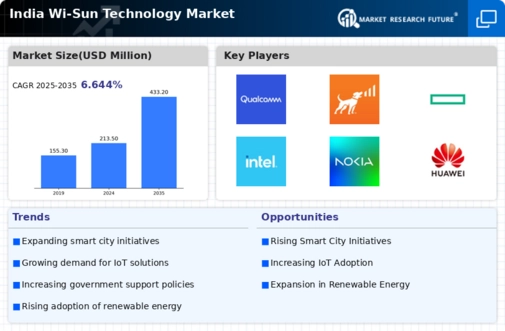Integration of IoT in Smart Cities
The integration of Internet of Things (IoT) technologies in smart cities is a pivotal driver for the wi sun-technology market, especially as urbanization accelerates in India. As urbanization accelerates in India, cities are increasingly adopting smart solutions to enhance infrastructure and services. The Indian government has initiated various smart city projects, which are expected to create a demand for advanced communication technologies. The wi sun-technology market stands to benefit from this trend, as it provides reliable, low-power connectivity for smart devices. With an estimated investment of $1.5 billion in smart city initiatives, the demand for wi sun-technology is likely to surge, facilitating efficient data transmission and management in urban environments.
Rising Adoption of Smart Agriculture
Smart agriculture practices are increasingly adopted in India, serving as a crucial driver for the wi sun-technology market. Farmers are increasingly utilizing technology to optimize crop yields and resource management. Wi sun technology facilitates the deployment of sensors and devices that monitor soil conditions, weather patterns, and crop health. This trend is supported by government initiatives aimed at enhancing agricultural productivity through technology. The Indian agricultural technology market is expected to grow at a CAGR of 25% over the next five years, indicating a strong potential for wi sun technology to play a vital role in transforming traditional farming into a more efficient and data-driven process.
Growing Need for Sustainable Solutions
Sustainability is increasingly emphasized in India, driving the wi sun-technology market. As industries and consumers alike seek eco-friendly alternatives, the demand for energy-efficient communication technologies is on the rise. Wi sun technology, known for its low power consumption and minimal environmental impact, aligns well with these sustainability goals. The Indian government has set ambitious targets for reducing carbon emissions, which could lead to increased adoption of wi sun solutions in various sectors, including agriculture and smart metering. This shift towards sustainable practices is expected to propel the wi sun-technology market, potentially increasing its market share by 20% over the next five years.
Advancements in Smart Metering Solutions
Advancements in smart metering solutions are significantly influencing the wi sun-technology market. With the Indian government pushing for the modernization of energy infrastructure, smart meters are becoming essential for efficient energy management. Wi sun technology offers a robust communication framework for these devices, enabling real-time data collection and analysis. The market for smart meters in India is projected to reach $2 billion by 2026, creating substantial opportunities for wi sun technology providers. This growth is driven by the need for accurate billing, reduced energy theft, and enhanced consumer engagement, all of which are critical for the future of energy distribution in India.
Increased Focus on Urban Mobility Solutions
The increased focus on urban mobility solutions is shaping the wi sun-technology market in India. As cities grapple with traffic congestion and pollution, there is a growing need for smart transportation systems. Wi sun technology can support vehicle-to-everything (V2X) communication, enhancing the efficiency of public transport and reducing travel times. The Indian government has allocated substantial funds for developing smart transportation infrastructure, which is expected to reach $3 billion by 2027. This investment is likely to drive the adoption of wi sun technology, as it provides the necessary connectivity for real-time data exchange between vehicles, traffic signals, and control centers.























Leave a Comment